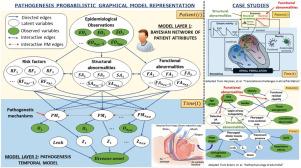Artificial Intelligence in Medicine ( IF 6.1 ) Pub Date : 2021-03-24 , DOI: 10.1016/j.artmed.2021.102056 Phat K Huynh 1 , Arveity Setty 2 , Hao Phan 3 , Trung Q Le 4

|
Disease pathogenesis, a type of domain knowledge about biological mechanisms leading to diseases, has not been adequately encoded in machine-learning-based medical diagnostic models because of the inter-patient variabilities and complex dependencies of the underlying pathogenetic mechanisms. We propose 1) a novel pathogenesis probabilistic graphical model (PPGM) to quantify the dynamics underpinning patient-specific data and pathogenetic domain knowledge, 2) a Bayesian-based inference paradigm to answer the medical queries and forecast acute onsets. The PPGM model consists of two components: a Bayesian network of patient attributes and a temporal model of pathogenetic mechanisms. The model structure was reconstructed from expert knowledge elicitation, and its parameters were estimated using Variational Expectation-Maximization algorithms. We benchmarked our model with two well-established hidden Markov models (HMMs) – Input-output HMM (IO-HMM) and Switching Auto-Regressive HMM (SAR-HMM) – to evaluate the computational costs, forecasting performance, and execution time. Two case studies on Obstructive Sleep Apnea (OSA) and Paroxysmal Atrial Fibrillation (PAF) were used to validate the model. While the performance of the parameter learning step was equivalent to those of IO-HMM and SAR-HMM models, our model forecasting ability was outperforming those two models. The merits of the PPGM model are its representation capability to capture the dynamics of pathogenesis and perform medical inferences and its interpretability for physicians. The model has been used to perform medical queries and forecast the acute onset of OSA and PAF. Additional applications of the model include prognostic healthcare and preventive personalized treatments.
中文翻译:

用于急性发作动态预测的疾病发病机制的概率领域知识模型
疾病发病机制是关于导致疾病的生物机制的一类领域知识,由于患者间的差异和潜在发病机制的复杂依赖性,尚未在基于机器学习的医学诊断模型中得到充分编码。我们提出:1)一种新颖的发病概率图形模型(PPGM)来量化支撑患者特定数据和发病领域知识的动态,2)一种基于贝叶斯的推理范例来回答医学查询和预测急性发作。 PPGM 模型由两个部分组成:患者属性的贝叶斯网络和发病机制的时间模型。通过专家知识获取重建模型结构,并使用变分期望最大化算法估计其参数。我们使用两个完善的隐马尔可夫模型 (HMM) – 输入输出 HMM (IO-HMM) 和切换自回归 HMM (SAR-HMM) 对我们的模型进行基准测试,以评估计算成本、预测性能和执行时间。阻塞性睡眠呼吸暂停 (OSA) 和阵发性心房颤动 (PAF) 的两个案例研究用于验证该模型。虽然参数学习步骤的性能与 IO-HMM 和 SAR-HMM 模型相当,但我们的模型预测能力优于这两个模型。 PPGM 模型的优点在于它能够捕捉发病机制的动态并进行医学推论,以及对医生的可解释性。该模型已用于执行医学查询并预测 OSA 和 PAF 的急性发作。该模型的其他应用包括预后医疗保健和预防性个性化治疗。











































 京公网安备 11010802027423号
京公网安备 11010802027423号